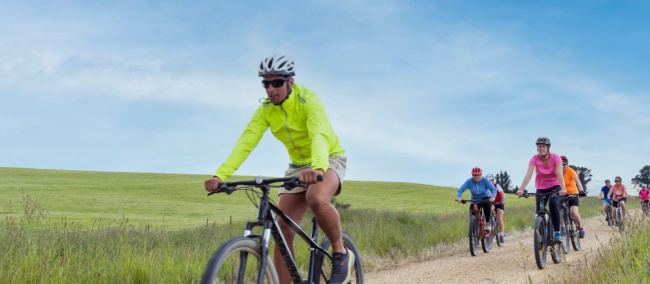
Group of cyclists riding Otago Rail Trail | DunedinNZ
6 essential bike gear tips
What clothing and equipment should you take on your cycling tour? It may seem like a mundane subject to think about, when all you want to do is hop on your bike and go. Yet, it is absolutely essential that you get the gear right!
The bottom line is that you have booked a cycling trip because you enjoy cycling. You want to soak up the New Zealand culture and Central Otago scenery at a relaxed pace from the comfortable saddle of your bike. These tips will help you prepare for your trip so that you'll have the best time and not be worrying about your fingers falling off.
1. Ensure you have quality wet weather gear
Invest in good quality wet weather gear - including a rain jacket and pack cover. You won't regret it. It protects against the elements, with windproof and water-resistant properties to shield you from unexpected rain as well as wind chill or snow.
On a social ride, which for all intents and purposes the vast majority of organised cycle trips are, there is nothing worse than riding in the rain without adequate protection - especially if it is cold rain!
- Garry Corbett
2. Replicate your comfortable set-up
Whilst it's not a requirement on our cycling trips that you bring your own gear, if you already have a comfortable set-up at home, it's a good idea to replicate it on your trip. This could include your saddle, clip-ins for SPD's and ergonomic handlebar grips. At our Trail Journeys HQ, we have a variety of bikes to choose from, including comfort bikes, mountain bikes and electric bikes. It's recommended to choose the setup that feels most comfortable to you.
When you hire one of our bikes, you will be given a helmet, repair kit and rear carry bag. Most bike seats can be adjusted to our bikes in the country and our travel experts are also always on-hand to advise on recommended gear.
3. Consider wearing a bike jersey
Bike jerseys with a number of pockets on the back are another good addition to your wardrobe for both comfort and convenience. Don't worry, not all of them look like a brightly coloured billboard.
The pockets can conveniently hold everything from snacks to cameras and money. It is important to note here that if you shop around you can purchase cycle jerseys that do not make you look like a Tour de France contender.
4. Cycling gloves make a big difference
Cycling gloves are another addition to your wardrobe that are highly recommended when bike riding. While gloves may seem like a small consideration, they serve a number of very important functions including grip and sun protection.
First and foremost, gloves keep the hot sun off the back of your hands, but on a more practical level they stop blisters, chafing and other discomfort caused by the constant friction of handlebars and road vibration against the skin of your hands - especially when they are damp with sweat.
The extra grip provided by gloves could mean the difference between staying on your seat or taking a tumble and landing on the ground. The improved grip enables better control of your bike because your hands are less likely to slip on the handlebars each time you turn.
- Garry Corbett
5. Comfort is key
While it's important to focus on fitness, one shouldn't forget about comfort. If you're feeling uncomfortable it will make it hard to enjoy your trip.
All your contact points must be really comfortable including your hands, backside and feet. If you are not used to long periods of riding we recommend buying a gel seat pad or padded cycling pants.
Sitting on a bike seat for multiple hours can present some challenges if you haven't done so for a long time, or at all. Some people like to bring padded bike pants, others gel seats, and while they all help to some degree nothing aids your buttocks better than getting it used to being on a bike seat gradually before your trip. Just like you wear your boots in to avoid blisters before a trip, wear your bum in by sitting on the bike before you travel.
- Brad Atwal
6. Wear synthetic clothing - not cotton
Carefully consider the clothing you pack before you begin your trip and consider investing in some quick-drying clothes. Clothing made of cotton does not dry quickly and can hold too much moisture.
It is best to bring along fast-drying clothing that are predominantly synthetic or of a synthetic blend. Cotton holds onto moisture and can be a cyclist's worst enemy. Not only does it look unsightly to be wearing a T-shirt and shorts soaked with sweat, but the moisture magnifies both heat and cold and can make things very uncomfortable.
- Garry Corbett
If you're cycling in the cooler months, have a read through our winter cycling gear tips and the benefits of strategic layering.